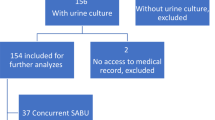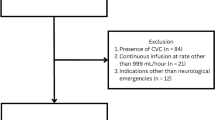Summary
Infection of cerebrospinal fluid (CSF) shunts is one of the major complications associated with their use and is usually managed by shunt removal, temporary insertion of an external drainage and implantation of a new shunt system. We have evaluated the efficacy of a rifampin-loaded silicone ventricular catheter to prevent bacterial colonization and infection in vitro and in an animal model.
On the basis of an incorporation process a rifampin-loaded catheter was developed which is capable of releasing rifampin in bacteriocidal concentrations for 60 days and more. In a stationary bacterial adherence assay usingS. epidermidis as test strain, the colonization resistance of the device was demonstrated.
To assess the capability of the catheter to prevent CSF shunt infections, a rabbit model was developed which allowed the establishment of a reliable and reproducible CSF infection by implantation of silicone catheters into the ventricle and inoculatingS. epidermidis (minimal dose 106 cfu) orS. aureus (minimal dose 103 cfu). Rifampinloaded catheters (12 animals inoculated with S. epidermidis, 8 animals inoculated with S. aureus) were compared with non-loaded (14 animals inoculated with S. epidermidis, 19 animals inoculated with S. aureus) control catheters, and infection was documented by clinical, microbiological and histological methods.
In contrast to the control group, none of the animals with rifampin-loaded catheters showed clinical signs of infection. Furthermore, in none of the materials obtained after sacrifice of the animals (catheter, brain tissue, CSF, blood) could the infecting bacteria be cultured, whereas in materials from animals with the unloaded catheter the infecting strains could always be cultured from the catheter and from surrounding brain tissue. The histological examination of catheter-adjacent tissue supported these findings.
We conclude that a rifampin-loaded silicone ventricular catheter is capable of completely preventing bacterial colonization and infection by staphylococci as the main causative organisms in CSF shunt infections and should be further evaluated in clinical trials.
Similar content being viewed by others
References
Bayston R (1980) The effect of antibiotic impregnation on the function of slit valves used to control hydrocephalus. Z Kinderchir 31: 353–359
Bayston R, Milner RDG (1981) Antimicrobial activity of silicone rubber used in hydrocephalus shunts, after impregnation with antimicrobial substances. J Clin Pathol 34: 1057–1062
Bayston R, Adroyewski V, Barsham S (1988) Use of an in vitro model to study eradication of catheter colonisation by Staphylococcus epidermidis. J Infect 16: 141–146
Bayston R, Barsham C (1988) Catheter colonisation: a laboratory model suitable for aetiological, therapeutic and preventive studies. Med Lab Sci 45: 235–239
Bayston R, Grove N, Siegel J,et al (1989) Prevention of hydrocephalus shunt catheter colonisation in vitro by impregnation with antimicrobials. J Neurosurg 52: 605–609
Bisno AL (1989) Infections of central nervus system shunts. In: Bisno AL, Waldvogel F (eds) Infections associated with indwelling mechanical devices. ASM, Washington, DC, pp 93–110
Blomstedt GC (1985) Infections in neurosurgery: a retrospective study of 1143 patients and 1517 operations. Acta Neurochir (Wien) 78: 81–90
Callaghan RP, Cohen SJ, Stewart JT (1961) Septicemia due to colonization of Spitz-Holter valves by staphylococci. Five cases treated with methicillin. BMJ 14: 860–863
Fokes EC (1970) Occult infections of ventriculoatrial shunts. J Neurosurg 33: 517–523
James HF (1984) Infections associated with cerebrospinal fluid prosthetic devices. In: Sugarman B, Young ES (eds) Infections associated with prosthetic devices. CRC, Boca Raton, Florida, pp 23–42
Jansen B, Kristinsson K, Jansen S, Peters G, Pulverer G (1992) In vitro efficacy of a central venous catheter complexed with iodine to prevent bacterial colonization. J Antimicrob Chemother 30: 135–139
Jansen B, Peters G (1991) Modern strategies in the prevention of polymer-associated infections. J Hosp Infect 19: 83–88
Jansen B, Jansen S, Peters G, Pulverer G (1992) In vitro efficacy of a central venous catheter (hydrocath) loaded with teicoplanin to prevent bacterial colonization. J Hosp Infect 22: 93–107
Jansen B, Schareina S, Treitz U, Peters G, Schumacher-Perdreau F, Pulverer G (1990) Antibiotic-containing polyurethanes for the prevention of foreign-body infectins. In: Gebelein CG, Dunne RL (eds) Progress in biomedical polymers. Plenum, New York, pp 347–354
Kloos WE, Schleifer KH (1975) Simplified scheme for routine identification of human Staphylococcus species. J Clin Microbiol 1: 82–88
Mayhall CG, Archer NH, Archer Lamb V,et al (1984) Ventriculostomy-related infections. N Engl J Med 310: 553–559
Odio C, McCracken GH, Nelson JD (1984) CSF shunt infections in pediatrics. AJD 138: 1103–1108
Peters G, Pulverer G (1984) Pathogenesis and management of Staphylococcus epidermidis plastic foreign body infections. J Antimicrob Chemother 14 [Suppl D]: 67–71
Randolph G, Leibrock L, Epstein M (1979) Long-term analysis of cerebrospinal fluid shunt infections. J Neurosurg 51: 804–811
Author information
Authors and Affiliations
Rights and permissions
About this article
Cite this article
Hampl, J., Schierholz, J., Jansen, B. et al. In vitro and in vivo efficacy of a rifampin-loaded silicone catheter for the prevention of CSF shunt infections. Acta neurochir 133, 147–152 (1995). https://doi.org/10.1007/BF01420065
Issue Date:
DOI: https://doi.org/10.1007/BF01420065




